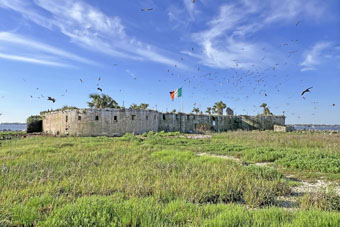
The six-member scientific team that launched a study in April of coastal birds residing in and near Charleston Harbor ─ including Castle Pinckney ─ completed its field work late July.
This is the second and final update since the project began. (See Initial Article) The first update on the project was posted on May 30 after the team completed the first two phases of its four-phase study. (See First Update)
“As of late July, we’ve completed all of our field work,” said Dr. Patrick Jodice, who led the project. “We’ve completed tagging adult coastal birds and collecting the requisite number of eggs. We’ve also collected a suite of environmental and biological samples to be analyzed for a wide range of polyfluoroalkyl (PFAS), including air, water, plankton, vegetation (e.g., salt marsh grasses), sediment, fish, and oysters/mussels. We collected the samples from sites throughout the lower reaches of the Ashely, Cooper and Wando rivers, as well as from the Intracoastal Waterway and Charleston Harbor.”
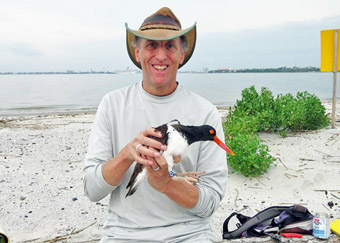
Dr. Patrick Jodice, Project Leader
Dr. Jodice’s team has been traveling in small boats to and from Castle Pinckney and other sites across the harbor to conduct field work during the past four months when weather has permitted. They have collected field data that will allow them to evaluate the bioaccumulation of PFAS in the local food webs, and to measure the levels of such contaminants in adult Eastern Brown Pelicans and American Oystercatchers (the two bird species studied), and their chicks and eggs.
During the next six to twelve months, Dr. Jodice’s team of scientists will partner with another team of scientists at the University of Rhode Island to study the large quantity of samples collected.
Field Work, the Project’s “First Step,” Completed
“I’d consider this project to be ‘successful to date’, because completing field work at the Castle Pinckney site and elsewhere in the harbor is only the project’s first step,” Dr. Jodice explained. “For a complex project, such as this, success is measured in small steps ─ not in one single/final accomplishment. And so far, we’ve safely collected the target samples, stored and cataloged them, and transported them to the lab at the University of Rhode Island.”
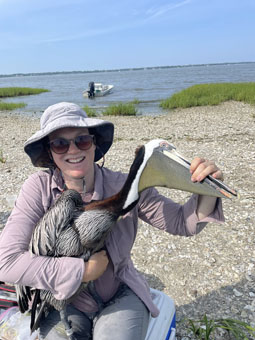
Amber Litterer, Clemson University
Scientists will obtain a better understanding during the next few months of how species of coastal birds use intertidal zones and islands in and around Charleston Harbor to forage, loaf and conduct other activities as they receive data from the birds they tagged. They will be able to map locations of such activities, and analyze movement patterns to figure out where coastal birds go.
This will help the scientists understand why coastal birds visit or do not visit certain areas, and help them understand the migration patterns of coastal birds as well.
As scientists process samples in the lab that they have collected from coastal birds, they will gain some initial insight into how high or low the levels of PFAS are in each of the sample types. But this is the key: After scientists have conducted a series of statistical analyses and ecological models, they should be able unlock more findings and gain deeper insights into data patterns that were not initially obvious.
“The final step,” Dr. Jodice said, “will be to combine our understanding of the movement patterns and habitat use of both species (Eastern Brown Pelicans and American Oystercatchers) with the patterns in PFAS levels among the environmental and biological samples. If this step is successful, we may be able to better understand exactly how and where each species is exposed to PFAS.”
Dr. Jodice plans to report preliminary results of his team’s study at a meeting in December 2024, and to provide an annual report to the project’s funder, the U.S. Department of Defense’s Strategic Environmental Research and Development Program, in early 2025. He then plans to produce the final report, and then begin publishing publications by late 2025.
Analyzing and Interpreting Data Requires “Substantial Amount of Time”
“It will take a substantial amount of time to analyze and interpret the large mass of data that we’ve collected during this study, and this is an important point I’d like to make for the general public,” Dr. Jodice said.“ For every day we spend in the field, we probably invest one to three days just managing and archiving the data and samples we collect. Given the number of different types of samples we collected, and the quantity of each type of sample we collected during this project, we will be running lab analyses for several months. The statistical analysis and writing will then take an additional number of months.
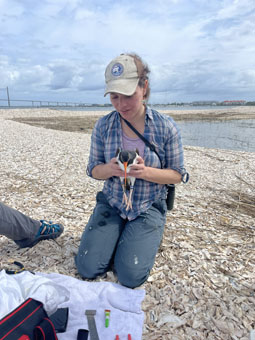
Dr. Juliet Lamb, The Nature Conservancy
“It is a tedious process that can drag out for a year or more for any single field season of collecting data,” he added. “But this is also an exciting time for us. You can think of it like opening gifts every few weeks. You examine some data and run an analysis, or get some lab results back, and you’re surprised by some pattern or result. And then over time you get to think about how it all fits together ─ and that takes different people with different areas of expertise to examine results and add their perspective.”
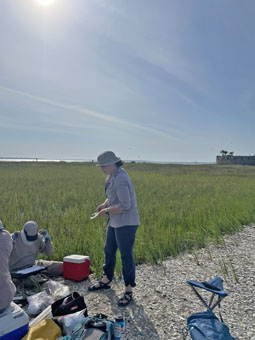
Rachel Nelson, University of Rhode Island
Dr. Jodice’s team will provide insight into the ecology and movement of the two species of coastal birds they studied ─ the Eastern Brown Pelican and the American Oystercatchers. The other team of scientists at the University of Rhode Island Rhode Island will do the same by studying the PFAS data that Dr. Jodice’s team collected.
Separately, the two teams would not be able to fully understand the big picture. But working together, these two teams should be able to piece together the story of PFAS exposure for coastal birds in the Charleston region.
Dr. Jodice thanked Castle Pinckney’s stakeholders, the Castle Pinckney Historical Preservation Society, and the Castle Pinckney Guardians, for granting his team permission to conduct its study at the Castle Pinckney site, and for taking care of the island and its historic fort.
“Stewardship of the island is a critical piece of the puzzle in studying coastal birds in this region,” he said.
NOTE: To learn more about the six-member scientific team, which conducted the four-month-long study at Castle Pinckney, and Seabird Tracking in the Atlantic, visit: https://www.atlanticseabirds.org/
